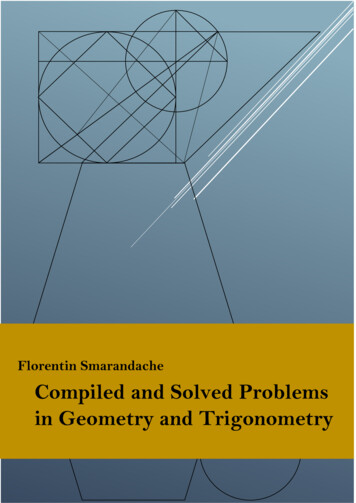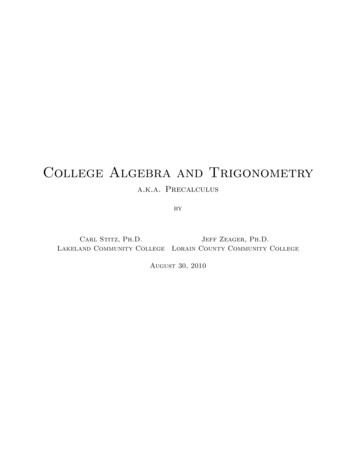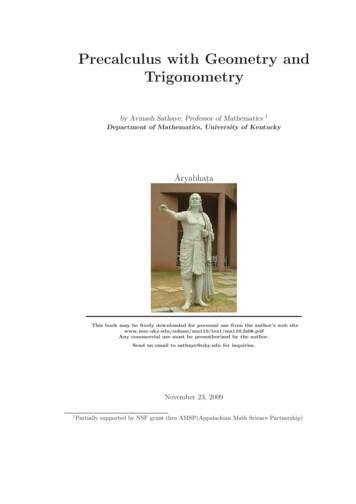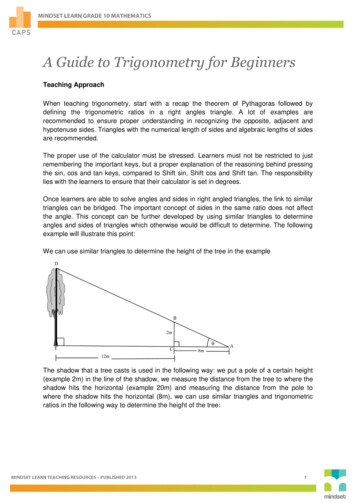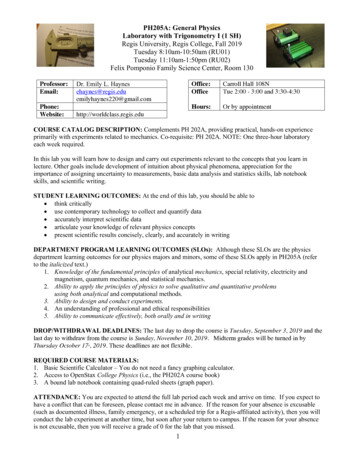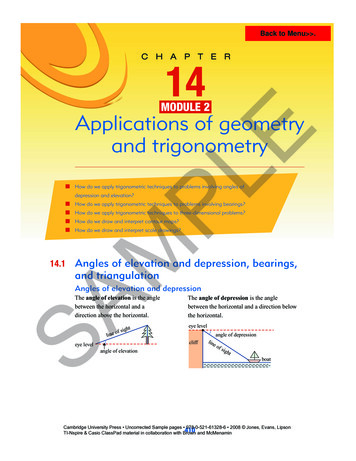
Transcription
P1: FXS/ABEP2: FXS9780521740517c14.xmlCUAU031-EVANSSeptember 6, 200813:36Back to Menu .C H A P T E R14MODULE 2PLEApplications of geometryand trigonometryHow do we apply trigonometric techniques to problems involving angles ofdepression and elevation?How do we apply trigonometric techniques to problems involving bearings?How do we apply trigonometric techniques to three-dimensional problems?How do we draw and interpret contour maps?14.1MHow do we draw and interpret scale drawings?Angles of elevation and depression, bearings,and triangulationAngles of elevation and depressionSAThe angle of elevation is the anglebetween the horizontal and adirection above the horizontal.oflinetsigheye levelangle of elevationThe angle of depression is the anglebetween the horizontal and a direction belowthe horizontal.eye levelangle of depressionclifflineof sightboatCambridge University Press Uncorrected Sample pages 978-0-521-61328-6 2008 Jones, Evans, Lipson410 and McMenaminTI-Nspire & Casio ClassPad material in collaboration with Brown
P1: FXS/ABEP2: FXS9780521740517c14.xmlCUAU031-EVANSSeptember 6, 200813:36Back to Menu .Chapter 14 — Applications of geometry and trigonometry411BearingsThe three-figure bearing (or compass bearing) is the direction measured clockwise fromnorth.The bearing of A from O is 030 .The bearing of C from O is 210 . The bearing of B from O is 120 .The bearing of D from O is 330 .NDN30 120 WEC210 SPLBE330 OWOSExample 1EAAngle of depressionThe pilot of a helicopter flying at 400 m observes a small boat at an angle of depression of1.2 . Draw a diagram and calculate the horizontal distance of the boat to the helicopter correctto the nearest 10 metres.SolutionHAH tan 1.2 ABM1.2 (angle of depression)400 m1.2 ASABExample 2400 tan 1.2 AB400AB tan 1.2AB 19 095.80056 . . .The horizontal distance is 19 100 mto the nearest 10 metres. Angle of elevationThe light on a cliff-top lighthouse, known to be 75 m above sea level, is observed from a boatat an angle of elevation of 7.1 . Draw a diagram and calculate the distance of the boat from thelighthouse to the nearest metre.SolutionL75 mA7.1 B75 tan 7.1 AB75 AB tan 7.1 602.135 . . .The distance of the boat from the lighthouseis 602 m to the nearest metre.Cambridge University Press Uncorrected Sample pages 978-0-521-61328-6 2008 Jones, Evans, LipsonTI-Nspire & Casio ClassPad material in collaboration with Brown and McMenamin
P1: FXS/ABEP2: FXS9780521740517c14.xmlCUAU031-EVANSSeptember 6, 200813:36Back to Menu .412Essential Further Mathematics — Module 2 Geometry and trigonometryExample 3Applying geometry and trigonometry with angle of elevationFrom a point A, a man observes that the angle of elevation of the summit of a hill is 10 . Hethen walks towards the hill for 500 m along flat ground. The summit of the hill is now at anangle of elevation of 14 . Draw a diagram and find the height of the hill above the level of A tothe nearest metre.ESolution1 Draw a diagram.HPL4 166 10 A5002 Find all the unknown angles that will berequired. This is done using propertiesof angles discussed in Chapter 12.M3 You choose to work in particular triangles.In this case it is triangle ABH.SA4 The information found in triangle ABH isthe length HB. This can now be used tofind HC in triangle BCH.5 Write down your answer.Example 414 BCThe magnitude of angleHBA (180 14) 166 .The magnitude of angleAHB 180 (166 10) 4 .Using the sine rule in triangle ABH:500HB sin 4sin 10 500 sin 10 HB sin 4 1244.67 . . .In triangle BCH:HC sin 14 HB HC HB sin 14 301.11 . . .The height of the hill is 301 m to thenearest metre.Bearings and Pythagoras’ theoremThe road from town A runs due west for 14 km to town B. A television mast is located duesouth of B at a distance of 23 km. Draw a diagram and calculate the distance of the mast fromthe centre of town A to the nearest kilometre. Find the bearing of the mast from the centre ofthe town.Cambridge University Press Uncorrected Sample pages 978-0-521-61328-6 2008 Jones, Evans, LipsonTI-Nspire & Casio ClassPad material in collaboration with Brown and McMenamin
P1: FXS/ABEP2: FXS9780521740517c14.xmlCUAU031-EVANSSeptember 6, 200813:36Back to Menu .Chapter 14 — Applications of geometry and trigonometry413SolutionB14 kmθ2314 θ 58.67 (to two decimal places)NAtan θ bearing 180 (90 58.67) 211.33 By Pythagoras’ theoremAT 2 AB 2 BT 2 142 232 725 AT 26.925 . . . The mast is 27 km from the centre of town A(to the nearest kilometre) and on a bearingof 211.33 .E23 kmExample 5PLTBearings and the cosine and sine rulesA yacht starts from a point A and sails on a bearing of 038 for3000 m. It then alters its course to a bearing of 318 , and aftersailing for 3300 m it reaches a point B.a Find the distance AB correct to the nearest metre.b Find the bearing of B from A correct to the nearest degree.BSAM3300 mN42 C 318 N38 3000ASolution1 To find the distance AB, the magnitudeof angle ACB needs to be determinedso that the cosine rule can beapplied in triangle ABC.The magnitude of angle ACB [180 (38 42)] 100 aBN42 100 NC38 38 ACambridge University Press Uncorrected Sample pages 978-0-521-61328-6 2008 Jones, Evans, LipsonTI-Nspire & Casio ClassPad material in collaboration with Brown and McMenamin
P1: FXS/ABEP2: FXS9780521740517c14.xmlCUAU031-EVANSSeptember 6, 200813:36Back to Menu .414Essential Further Mathematics — Module 2 Geometry and trigonometryAB 2 30002 33002 2 3000 3300 cos(100 ) 23 328 233.92 AB 4829.93104 . . .The distance of B from A is 4830 m(to the nearest metre).2 Apply the cosine rule in triangleABC.3 Write down your answer.b3300AB sin Asin 100 3300 sin 100 sin A AB sin A 0.6728 . . . A (42.288 . . .) The bearing of B from A 360 (42.29 38 ) 355.71 The bearing of B from A is 356 to thenearest degree.TriangulationPLETo find the bearing of B from A, themagnitude of angle BAC must firstbe found. The sine rule can be used.MSurveyors sometimes need to measure distances to inacessible points, or measure lengths thatare impossible to measure directly. The method of triangulation involves using the theory ofsolving triangles developed in this module.Example 6TriangulationSATwo points A and B are on opposite sides of a lake so that the distancebetween them cannot be measured directly. A third point, C, is chosenat a distance of 100 m from A and with angles BAC and BCA of 65 and 55 respectively. Calculate the distance between A and Bcorrect to two decimal places.SolutionThe magnitude of angle ABC is 60 . Using the sine rule for triangle ABCB65 55 A100 mC100AB sin 60sin 55 100 AB sin 55 sin 60 94.587 . . .The length of AB is 94.59 m (correct to two decimal places).Cambridge University Press Uncorrected Sample pages 978-0-521-61328-6 2008 Jones, Evans, LipsonTI-Nspire & Casio ClassPad material in collaboration with Brown and McMenamin
P1: FXS/ABEP2: FXS9780521740517c14.xmlCUAU031-EVANSSeptember 6, 200813:36Back to Menu .Chapter 14 — Applications of geometry and trigonometry415Exercise 14A1 The angle of elevation of the top of an old chimney stack at a point 40 m from its base is41 . Find the height of the chimney.2 A ship sails 10 km north and then 15 km east. What is its bearing from the starting point?E3 From the top of a vertical cliff 130 m high the angle of depression of a buoy at sea is 18 .What is the distance of the buoy from the foot of the cliff?4 The bearing of a point A from a point B is 207 . What is the bearing of B from A?PL5 A man standing on top of a mountain observes that the angle of depression to the foot of abuilding is 41 . If the height of the man above the foot of the building is 500 m, find thehorizontal distance from the man to the building.6 A tower 110 m high stands on the top of a hill. From apoint A at the foot of the hill the angle of elevation of thebottom of the tower is 7 , and that of the top is 10 .a Find the magnitude of angles TAB, ABT and ATB.b Use the sine rule to find the length AB.c Find CB, the height of the hill.10 7 ATB 110 mCM7 The bearing of a ship S from a lighthouse A is 055 . A second lighthouse B is due east of A.The bearing of S from B is 302 . Find the magnitude of angle ASB.8 A yacht starts from L and sails 12 km due east to M. It then sails 9 km on a bearing of 142 to K. Find the magnitude of angle MLK.SA9 The bearing of C from A is 035 .The bearing of B from A is 346 .The distance of C from A is 340 km.The distance of B from A is 160 km.a Find the magnitude of angle BAC.b Use the cosine rule to find the distance of B to C.CNB340 km160 km346 35 A10 Point S is at a distance of 120 m from the base of a building.On the building is an aerial, AB.The angle of elevation from S to A is 57 .The angle of elevation from S to B is 59 .a Find the distance OA.b Find the distance OB.c Find the distance AB.BAS57 59 120 mCambridge University Press Uncorrected Sample pages 978-0-521-61328-6 2008 Jones, Evans, LipsonTI-Nspire & Casio ClassPad material in collaboration with Brown and McMenaminO
P1: FXS/ABEP2: FXS9780521740517c14.xmlCUAU031-EVANSSeptember 6, 200813:36Back to Menu .416Essential Further Mathematics — Module 2 Geometry and trigonometry11 A man lying down on top of a cliff 40 m high observes the angle of depression to a buoy inthe sea below to be 20 . If he is in line with the buoy, calculate the distance between thebuoy and the foot of the cliff, which may be assumed to be vertical.12 P and Q are points on the bank of a river. A tree isat a point R on the opposite bank such that QPRis 53 . and RQP is 51 .a Find:i RPRii RQ51 53 PQE200 mb T is a point between P and Q such that PTR is aright angle. Find RT and hence the width of the river correct to two decimal places.APL13 Two points A and B are on opposite sides of a lake so that thedistance between them cannot be measured directly. A thirdpoint, C, is chosen at a distance of 300 m from A and withangles BAC and BCA of 80 and 53 respectively. Calculatethe distance between A and B.80 53 CB14 A man standing on top of a cliff 50 m high is in line with two buoys whose angles ofdepression are 18 and 20 . Calculate the distance between the buoys.M15 From a ship S, two other ships P and Q are on bearings 320 and 075 respectively. Thedistance PS 7.5 km and the distance QS 5 km. Find the distance PQ.16 A ship leaves port A and steams 15 km due east. It then turns and steams for 22 km duenorth.a What is the bearing of the ship from A?b What is the bearing of port A from the ship?Schurch spireSA17 A man walking due east along a level road observes aNchurch spire from point A. The bearing of theNspire from A is 072 . He then walks 150 m to72 67 point B where the bearing is 067 .roadA 150 m Ba Find the distance of the church spire fromXeastB (i.e. BS).b Find the distance of the church spire fromthe road (i.e. SX).18 From the top of a communications tower, the angles ofdepression of two points A and B on a horizontal linethrough the foot of the tower are 30 and 40 . The distancebetween the points is 100 m. Find:30 40 Ttop of towera the distance AT40 30 base of towerBAb the distance BT100 mc Universitythe heightof thetower Sample pages 978-0-521-61328-6 2008 Jones, Evans, LipsonCambridgePress UncorrectedTI-Nspire & Casio ClassPad material in collaboration with Brown and McMenamin
P1: FXS/ABEP2: FXS9780521740517c14.xmlCUAU031-EVANSSeptember 6, 200813:36Back to Menu .Chapter 14 — Applications of geometry and trigonometry41719 A yacht starts from point A and sails on a bearing of 035 for 2000 m. It then alters itscourse to one in a direction with a bearing of 320 and after sailing for 2500 m it reachespoint B.a Find the distance AB.Problems in three dimensionsExample 7EProblems in three dimensions are solved by picking out triangles from a main figure andfinding lengths and angles through these triangles.Applications in three dimensionsABCDEFGH is a cuboid. Find:a distance DBb distance HBc the magnitude of angle HBDd distance HAe the magnitude of angle HBAHPLSolutionGEDA10 cm7 cmFC8 cmBMa Strategy: You always work in triangles to obtain values. Here we start with triangle ABD.DD B 2 82 1028 cmAB10 cmSA14.2b Find the bearing of B from A. 164 DB 164 D B 12.806 . . .The length of DB is 12.81 cm correct to twodecimal places.b Strategy: Now use the information from a in triangle BDH.HB 2 HD 2 DB 2 2 72 164 213H7 cmD 164 cmθBc Strategy: Triangle BDH is again used. HB 213 14.59 . . .The length of HB is 14.59 cm correct to twodecimal places.7HD 0.5466 . . . BD164θ 28.66 correct to two decimal places.Tan θ Cambridge University Press Uncorrected Sample pages 978-0-521-61328-6 2008 Jones, Evans, LipsonTI-Nspire & Casio ClassPad material in collaboration with Brown and McMenamin
P1: FXS/ABEP2: FXS9780521740517c14.xmlCUAU031-EVANSSeptember 6, 200813:36Back to Menu .418Essential Further Mathematics — Module 2 Geometry and trigonometryd Strategy: Triangle ABH is used to find HA.EH7 cmA HA D8 cmHA 2 82 72 64 49 113113e Strategy: Apply the cosine rule to triangle ABH to find the magnitude of angle HBA.HA 2 AB 2 HB 2 2 AB HB cos B113 100 213 2 10 213 cos BEH 213 cmAB10 cmExample 8 cos B 200 20 213 cos B 0.68518 . . .B 46.75 (correct to two decimal places)PL 113 cmUsing Pythagoras’ theorem in three dimensionsMThe diagram shows a pyramid with a square base. The base hassides 6 cm long and the edges VA, VB, VC, VD are each 10 cm long.a Find the length of DB. b Find the length of BE.c Find the length of VE. d Find the magnitude of angle VBE. 10 cmGive all answers correct to two decimal places.SolutionABSAaEDb6 cm6 cmCVABED6 cmCD B 2 62 62 72 D B 8.4852 . . .The length of DB is 8.49 cm correctto two decimal places.1BE D B2 1 BE 72 4.2426 . . .2The length of BE is 4.24 cm correct to two decimal places.Cambridge University Press Uncorrected Sample pages 978-0-521-61328-6 2008 Jones, Evans, LipsonTI-Nspire & Casio ClassPad material in collaboration with Brown and McMenamin
P1: FXS/ABEP2: FXS9780521740517c14.xmlCUAU031-EVANSSeptember 6, 200813:36Back to Menu .Chapter 14 — Applications of geometry and trigonometry419cVV E 2 V B 2 EB 21 100 724 100 18 82θE V E 82 9.0553 . . .The length of VE is 9.06 cm correct to two decimal places.BPLE 82VEd sin θ VB10 0.9055 . . . θ 64.90 The magnitude of angle VBE is 64.90 correct to two decimal places.Example 9Using Pythagoras’ theorem and tan in three dimensionsA communications mast is erected at the corner A of a rectangularcourtyard ABCD whose sides measure 60 m and 45 m. If theDangle of elevation of the top of the mast from C is 12 , find:Ma the height of the mastb the angle of elevation of the top of the mastfrom B (where AB 45 m)Give answers correct to two decimal places.H60 mCA45 mBSolutionaSAACC60 m12 7545 mAC 2 AB 2 CB 2 452 602 5625 AC 75BHAHA tan 12 75 HA 75 tan 12 15.9417The height of the mast is 15.94 m correct to two decimal places.bBθ45HAHA45 0.3542 . . . θ 19.51 tan θ The angle of elevation of the top of the mast, H, from B is 19.51 correct to two decimalplaces.Cambridge University Press Uncorrected Sample pages 978-0-521-61328-6 2008 Jones, Evans, LipsonTI-Nspire & Casio ClassPad material in collaboration with Brown and McMenamin
P1: FXS/ABEP2: FXS9780521740517c14.xmlCUAU031-EVANSSeptember 6, 200813:36Back to Menu .420Essential Further Mathematics — Module 2 Geometry and trigonometryExercise 14BABCEF5 cm12 cmGE1 ABCDEFGH is a cuboid with dimensions as shown.a Find the length of FH.b Find the length of BH, correct to two decimal places.Dc Find the magnitude of angle BHF, correct to8 cmone decimal places.Hd Find the magnitude of angle BHG, correct totwo decimal places.2 VABCD is a right pyramid with a square base. The sidesof the base are 8 cm in length. The height, VF, of thepyramid is 12 cm.PLVa Find EF.b Find the magnitude of angle VEF.Dc Find the length of VE.Ed Find the length of a sloping edge.Fe Find the magnitude of angle VAD.ABf Find the surface area of the pyramid.Where decimals are involved, give all answers correct to two decimal places.M3 A tree stands at the corner of a square playing field. Each sideof the square is 100 m long. At the centre of the field a treesubtends an angle of 20 . What angle does it subtend at eachof the other three corners of the field, correct tothe nearest degree?C100 m20 100 mBSA4 Suppose that A, C and X are three points in a horizontalplane and B is a point vertically above X. If the length ofAC 85 m and the magnitudes of angles BAC, ACB andBCX are 45 , 90 and 32 respectively, find:a the distance CB correct to the nearest metreb the height XB correct to the nearest metreA45 85 mXC32 5 Standing due south of a tower 50 m high, the angle of elevation of the top is 26 . What isthe angle of elevation after walking a distance 120 m due east?6 From the top of a cliff 160 m high two buoys are observed. Their bearings are 337 and308 . Their respective angles of depression are 3 and 5 . Calculate the distance betweenthe buoys, correct to the nearest metre.Cambridge University Press Uncorrected Sample pages 978-0-521-61328-6 2008 Jones, Evans, LipsonTI-Nspire & Casio ClassPad material in collaboration with Brown and McMenamin
P1: FXS/ABEP2: FXS9780521740517c14.xmlCUAU031-EVANSSeptember 6, 200813:36Back to Menu .Chapter 14 — Applications of geometry and trigonometry4217 Find the magnitude of each of the following anglesfor the cuboid shown:a ACEb HDFc ECHHEGFD12 cmAB6 cmC5 cmE8 From a point A due north of a tower the angle of elevation to the top of the tower is 45 .From a point B, 100 m on a bearing of 120 from A the angle of elevation is 26 . Find theheight of the tower.9 A and B are two positions on level ground. From an advertising balloon at a vertical heightof 750 m, A is observed in an easterly direction and B at a bearing 160 . The angles ofdepression of A and B as viewed from the balloon are 40 and 20 respectively. Find thedistance between A and B.VPL10 Angles VBC, VBA and ABC are right angles.a Find the distance VA. b Find the distance VC.c Find the distance AC.d Find the magnitude of angle VCA.8 cmB8 cm6 cmCA11 A right pyramid, height 6 cm, stands on a square base of side 5 cm. Find:b the area of a triangular faceMa the length of a sloping edgeO'12 A light aircraft flying at a height of 500 m abovethe ground is sighted by an observer stationedat a point O on the ground, measured to beB'O1 km from the plane. The aircraft is flying1000 msouth west (along A B ) at 300 km/h.500 mA' light aircraft500 m45 AESAa How far will it travel in one minute?Bb Find its bearing from O(O ) at this time.c What will be its angle of elevation from O at this time?14.3Contour mapsEDCABHB'C' D' E'200 m150 m100 m50 msea levelThis diagram shows a hill over 200 m high rising from sea level. B is a point on the hill 50 mabove sea level. A line drawn through B passes through all other points that are 50 m above sealevel. This is called the 50 m contour line.Cambridge University Press Uncorrected Sample pages 978-0-521-61328-6 2008 Jones, Evans, LipsonTI-Nspire & Casio ClassPad material in collaboration with Brown and McMenamin
P1: FXS/ABEP2: FXS9780521740517c14.xmlCUAU031-EVANSSeptember 6, 200813:36Back to Menu .422Essential Further Mathematics — Module 2 Geometry and trigonometrySimilarly, C, D and E mark the levels of the 100 m, 150 m and 200 m contour lines respectively.Imagine that the contour lines are all painted black and then projected onto the base as shownbelow.B'C' D'E'EAsea level50 m100 m150 m200 mPLThis is called a contour map.Note that the map does not give the actual distance between B and C but gives the horizontaldistance.In order to find the distance between B and C, first determine from the diagram (drawn to ascale) the horizontal distance B C . Suppose this distance is 80 m. Then triangle BCH in thefirst diagram can be used to find the distance between B and C and the average slope betweenB and C.C50 mθ80 mHMBBC 2 BH 2 CH 2 6400 2500 8900 BC 8900 94.3398 . . .The distance BC is 94 m to the nearest metre.50CH 0.625BH80and tan 0.625which implies 32.00 correct to two decimal placesThe average slope SAThe angle of elevation of C from B is 32 to the nearest degree.A cross-sectional profile can be drawn from a contour map for a given cross-section AB.This is illustrated below.500 mA300 m400 m 200 m B100 m500 m400 m300 m200 m100 m-Cambridge University Press Uncorrected Sample pages 978-0-521-61328-6 2008 Jones, Evans, LipsonTI-Nspire & Casio ClassPad material in collaboration with Brown and McMenamin
P1: FXS/ABEP2: FXS9780521740517c14.xmlCUAU031-EVANSSeptember 6, 200813:36Back to Menu .Chapter 14 — Applications of geometry and trigonometry423Exercise 14C1 Draw a cross-sectional profile for each of the following maps with the given cross-sectionAB.a150 mBA50 m100 mAO150 m100 m50 mBEObPL2 Two places on a map are 5 cm apart. One is on a 50 m contour and the other on a 450 mcontour. If the scale of the map is 1 cm to 1 km, what is the angle of elevation from the firstto the second place?M3 a For this diagram the horizontal distance from A to BCis 400 m. Find:i the distance from A to BBA150 mii the angle of elevation of B from A100mb The horizontal distance from B to C is 1 km. Find:50 mi the distance of B from Cii the angle of elevation of B from C4 Draw a possible contour map to match thegiven cross-section.SAA250 m200 m150 m100 m50 mBCambridge University Press Uncorrected Sample pages 978-0-521-61328-6 2008 Jones, Evans, LipsonTI-Nspire & Casio ClassPad material in collaboration with Brown and McMenamin
P1: FXS/ABEP2: FXS9780521740517c14.xmlCUAU031-EVANSSeptember 6, 200813:36Back to Menu .Essential Further Mathematics — Module 2 Geometry and trigonometryKey ideas and chapter summaryThe angle of elevation is the angle between the horizontal anda direction above the horizontal. (See p. 370)Angle of depressionThe angle of depression is the angle between the horizontaland a direction below the horizontal. (See p. 370)Three-figure bearingThe three-figure bearing is the direction measured from northclockwise (also called compass bearing).Contour line/diagram/mapA contour line joins all the points that are the same distanceabove sea level. (See p. 381)A contour diagram is made up of a number of contour linesshowing the whole feature, e.g. a hill.A contour map is produced when the contour lines areprojected onto the base of the diagram.PLSkills checkEAngle of elevationMHaving completed this chapter you should be able to:apply the idea of angle of depressionapply the idea of angle of elevationapply the idea of a bearinguse, construct and interpret contour mapsMultiple-choice questions1 A man walks 5 km due east followed by 7 km due south. The bearing he must take toreturn to the start is:B 306 C 324 D 332 E 348 A 036 SAReview4242 A boat sails at a bearing of 215 from A to B. The bearing he would take from B toreturn to A is:B 055 C 090 D 215 E 250 A 035 3 From a point on a cliff 500 m above sea level, the angle of depression to a boat is20 . The distance from the foot of the cliff to the boat to the nearest metre is:A 182 mB 193 mC 210 mD 1374 mE 1834 m4 A tower 80 m high is 1.3 km away from a point on the ground. The angle of elevationto the top of the tower from this point, correct to the nearest degree is:B 4 C 53 D 86 E 89 A 1 5 A boat sails from a harbour on a bearing of 035 for 100 km. It then takes a bearingof 190 for 50 km. The distance from the harbour, correct to the nearest km, is:A 51 kmB 58 kmC 59 kmD 108 kmE 3437 kmCambridge University Press Uncorrected Sample pages 978-0-521-61328-6 2008 Jones, Evans, LipsonTI-Nspire & Casio ClassPad material in collaboration with Brown and McMenamin
P1: FXS/ABEP2: FXS9780521740517c14.xmlCUAU031-EVANSSeptember 6, 200813:36Back to Menu .Chapter 14 — Applications of geometry and trigonometry425A7 The diagram shows a rectangular prism (cuboid).The dimensions are as marked. The length of thediagonal is closest to:A 26 cmB 30 cmC 31 cmBD 34 cmE 39 cm10 cm16 cmE24 cmV8 VABC is a pyramid. V is vertically above B andtriangle ABC has a right angle at B. The distancebetween points A and C is closest to:A 12 cmB 21 cmC 26 cmD 30 cmE 36 cm12 cm20 cm18 cmPLBCAM9 A ship travels from a point A to B on a bearing of045 for a distance of 60 km. It then travels to apoint C on a bearing of 120 for a distance of100km. The distance of C to A is closest to:A 123 kmB 125 kmC 127 kmD 129 kmE 131 kmNB 120 NSA16 cmB 8 cm8 cm11 A hiker walks 4 km from point A on a bearing of 030 topoint B and then 6 km on a bearing of 330 to point C.The distance AC in kilometres is:4 sin 302C 6 42 48 cos 120 E 52CA10 A right pyramid with a square base is shown inthe diagram. Each edge of the square base haslength 8 centimetres and the height of the pyramidis 16 cm. The length of a sloping edge of thepyramid in centimetres is: A 288B 155C 125 E 425D 324A100 km45 60 kmNC6 km62 42 48 cos 120 D 6 sin 60 B4 kmACambridge University Press Uncorrected Sample pages 978-0-521-61328-6 2008 Jones, Evans, LipsonTI-Nspire & Casio ClassPad material in collaboration with Brown and McMenaminReview6 A hiker walks 5.2 km on a bearing of 160 and then takes a bearing of 035 andwalks 7 km. The bearing he must take to return directly to the start is:B 215 C 223 D 235 E 262 A 047
P1: FXS/ABEP2: FXS9780521740517c14.xmlCUAU031-EVANSSeptember 6, 200813:36Back to Menu .Essential Further Mathematics — Module 2 Geometry and trigonometry12 A ship travels from P to Q on a course of 050 for 35 kmand then from Q to R on a course of 020 for 20 km.How far east of P is R in kilometres?A 35 sin 50 20 sin 20 B 35 cos 50 20 cos 20 35203520D C sin 40cos 70 sin 40sin 70 E 55 cos 11020 kmQ35 kmPtrack350AB300250200150100PLA hiker walks up the hill from a point A onthe 100 m contour line to a point B on the350 m contour line along the track shown.From the contour map the steepest partof the track is between the:NE13 The contour map of a region of a hill is shown here.A 100 m and 150 m contour linesC 200 m and 250 m contour linesE 300 m and 350 m contour linesRNscale 1 : 10 000B 150 m and 200 m contour linesD 250 m and 300 m contour linesExtended-response questionsM1 Aristotle valued the aesthetic appearance of the Greekcity wall. He was disturbed at the earlier polygonal walls,which were made of irregular shapes. He convinced Philip,King of Macedonia, that the walls of Miea should beconstructed with regular hexagonal blocks as shown here.The diagram opposite shows a hexagonal face of one of1.5 mthe blocks. A and B mark two adjacent corners on the faceOof the block while O marks the centre of the hexagonalface. The length of each edge of each hexagon is 1.5 m.Point C is midway between A and B.A C Ba Explain why the length of OA is 1.5 m.b Taking the length of OA to be 1.5 m, find the length ofOC in metres. Give your answer correct to three decimalplaces.c The wall is ten blocks high. Find the height of the wallin metres. Give your answer correct to the nearest metre.1.5 md Find the area of the shaded triangle (see diagram) drawnOon a hexagonal face of one of the blocks. Give youranswer in square metres correct to three decimal places.e Find the area of the hexagonal face of one of the blocks.BGive your answer in square metres correct to one decimal place. ASAReview426Cambridge University Press Uncorrected Sample pages 978-0-521-61328-6 2008 Jones, Evans, LipsonTI-Nspire & Casio ClassPad material in collaboration with Brown and McMenamin
P1: FXS/ABEP2: FXS9780521740517c14.xmlCUAU031-EVANSSeptember 6, 200813:36Back to Menu .Chapter 14 — Applications of geometry and trigonometry427Reviewf The hexagonal blocks are 1.2 m deep. Find the volume ofone of the hexagonal blocks. Give your answer in cubicmetres correct to one decimal place.1.5 m1.2mPLEAristotle wanted to see a scale model of a section of the wall before it was built.The scale he chose was 1 : 25.g What would be the length of an edge of a hexagonal faceof a block for the model? Give your answer in centimetres.h What is the ratio of the volume of a block in themodel to the volume of a block in the actual wall?A part of the wall is to cross a marshland. Aristotlewanted to find out the length of this part of the wallbut did not want to get his sandals muddy. Toovercome the problem, Aristotle made themeasurements shown on the diagram.i Find the distance AC in metres, correctDto two decimal places.j Find the length of the wall to be constructed acrossthe marshland. Give your answer to the nearest metre.Amarshland20 Cwall50 B20 mM20 mSANorth2 From a point C, by looking due north, a girl can see abeacon at point B. She can also see a tower at point T,which is 5 km away on a bearing of 056 . The tower atTBpoint T is due east of the beacon at B.5 kma Calculate the length of BT, the distance of the tower56 from the beacon. Give your answer correct to threeCdecimal places.b If she looks a further 22 from the tower at T theNorthgirl can see a radio mast at point M, which is 9 kmaway.i What is the bearing of the mast at point M from C?T5 kmii What is the distance between the tower and the56 22 mast correct to three decimal places?9 kmEastCMEast(cont’d.)Cambridge University Press Uncorrected Sample pages 978-0-521-61328-6 2008 Jones, Evans, LipsonTI-Nspire & Casio ClassPad material in collaboration with Brown and McMenamin
P1: FXS/ABEP2: FXS9780521740517c14.xmlCUAU031-EVANSSeptember 6, 200813:36Back to Menu .Essential Further Mathematics — Module 2 Geometry and trigonometryc The girl now walks due east from C.i How far must she walk until
P1: FXS/ABE P2: FXS 9780521740517c14.xml CUAU031-EVANS September 6, 2008 13:36 414 Essential Further Mathematics — Module 2 Geometry and trigonometry 2 Apply the cosine rule in triangle ABC. 3 Write down your answer. To find the bearing of B from A, the magnitude of
